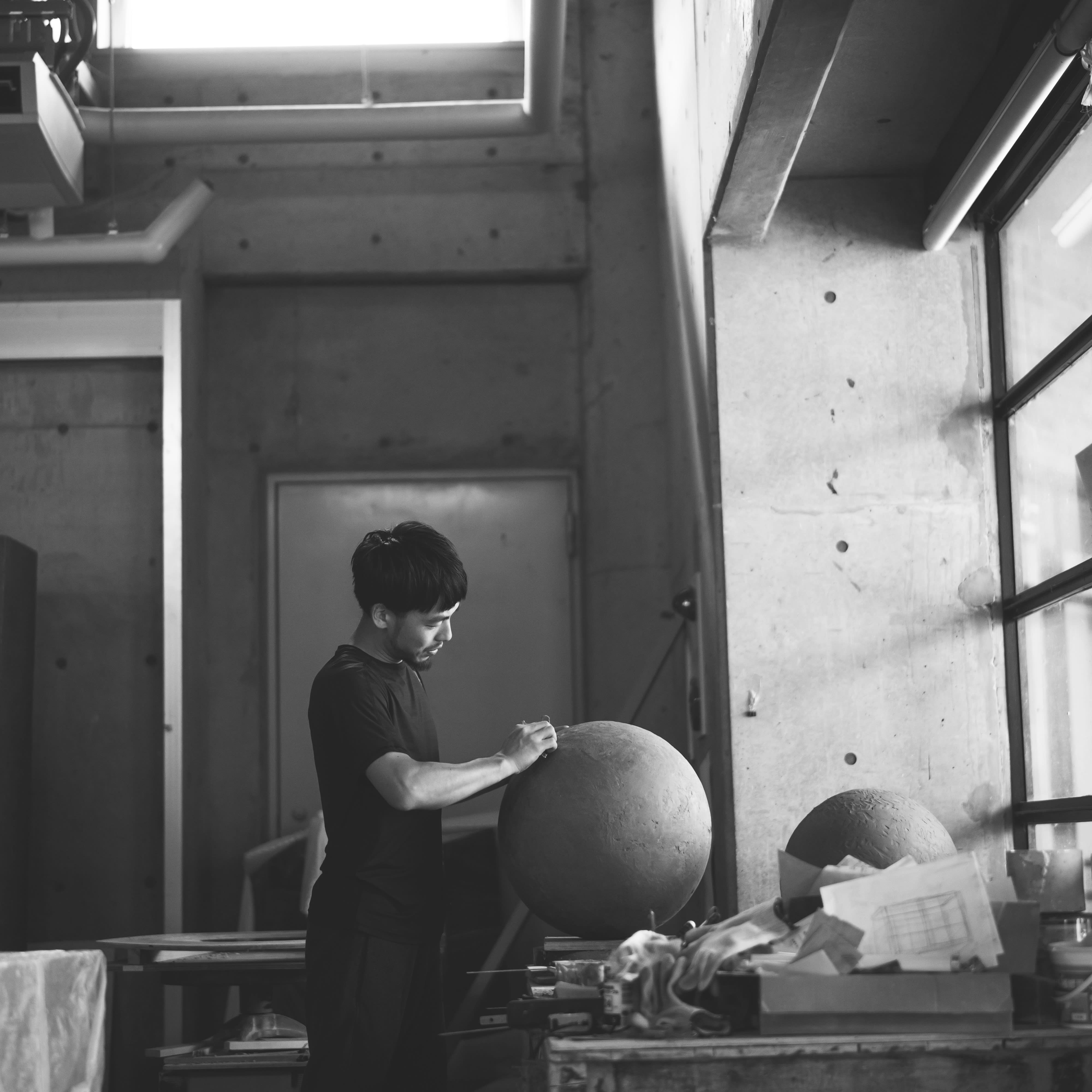Tomonari Hashimoto is based in Shigaraki, and has been exhibited widely across Japan, in both solo and group exhibitions, as well as in competitions. In 2017, Tomonari was artist in residence at the ‘Shigaraki Ceramic Cultural Park’, which allowed him to make ambitious large-scale work. Although his current work significantly varies in scale. In 2019, Tomonari held his first overseas solo exhibition in Hong Kong, and later the same year he was chosen as the on-site exhibitor at the ‘Korean International Ceramic Biennale’ in Icheon World Ceramic Center. He was selected as one of the youngest finalists at the ‘LOEWE Craft Prize 2019’ which was exhibited at the Sogetsu Kaikan in Tokyo. In 2020 his work was acquired by The Victoria and Albert Museum, London, UK for their permanent collection.
Tomonari Hashimoto’s process is characterised by simplicity, hand-shaping a ‘membrane of clay’ and bisque firing them, then applying a low-temperature glaze mixed with metal oxide, and after this the piece is fired once more. Tomonari hand builds a Kiln around each of his works, using gas burners to raise the temperature he then pours buckwheat or rice husks and carbonises them to develop the metal oxides and the oil-like, fluid surface to the clay bodies.
Through a dedicated reverence for material processes and the essences within things, Tomonari states that his practice enables him ‘to pay attention to things and to reflect on one’s inner self’. The work’s sculptural presence, such as the spheres within Earthly Bodies, or his leaning planks and columns, invokes mystic even esoteric themes. Such encounters with the work brings the impulses of minimalism to the fore in Tomonari’s ceramic practice, while working with a potent and stark vocabulary.
 Tomonari Hashimoto is based in Shigaraki, and has been exhibited widely across Japan, in both solo and group exhibitions, as well as in competitions. In 2017, Tomonari was artist in residence at the ‘Shigaraki Ceramic Cultural Park’, which allowed him to make ambitious large-scale work. Although his current work significantly varies in scale. In 2019, Tomonari held his first overseas solo exhibition in Hong Kong, and later the same year he was chosen as the on-site exhibitor at the ‘Korean International Ceramic Biennale’ in Icheon World Ceramic Center. He was selected as one of the youngest finalists at the ‘LOEWE Craft Prize 2019’ which was exhibited at the Sogetsu Kaikan in Tokyo. In 2020 his work was acquired by The Victoria and Albert Museum, London, UK for their permanent collection.Tomonari Hashimoto’s process is characterised by simplicity, hand-shaping a ‘membrane of clay’ and bisque firing them, then applying a low-temperature glaze mixed with metal oxide, and after this the piece is fired once more. Tomonari hand builds a Kiln around each of his works, using gas burners to raise the temperature he then pours buckwheat or rice husks and carbonises them to develop the metal oxides and the oil-like, fluid surface to the clay bodies.Through a dedicated reverence for material processes and the essences within things, Tomonari states that his practice enables him ‘to pay attention to things and to reflect on one’s inner self’. The work’s sculptural presence, such as the spheres within Earthly Bodies, or his leaning planks and columns, invokes mystic even esoteric themes. Such encounters with the work brings the impulses of minimalism to the fore in Tomonari’s ceramic practice, while working with a potent and stark vocabulary.
Tomonari Hashimoto is based in Shigaraki, and has been exhibited widely across Japan, in both solo and group exhibitions, as well as in competitions. In 2017, Tomonari was artist in residence at the ‘Shigaraki Ceramic Cultural Park’, which allowed him to make ambitious large-scale work. Although his current work significantly varies in scale. In 2019, Tomonari held his first overseas solo exhibition in Hong Kong, and later the same year he was chosen as the on-site exhibitor at the ‘Korean International Ceramic Biennale’ in Icheon World Ceramic Center. He was selected as one of the youngest finalists at the ‘LOEWE Craft Prize 2019’ which was exhibited at the Sogetsu Kaikan in Tokyo. In 2020 his work was acquired by The Victoria and Albert Museum, London, UK for their permanent collection.Tomonari Hashimoto’s process is characterised by simplicity, hand-shaping a ‘membrane of clay’ and bisque firing them, then applying a low-temperature glaze mixed with metal oxide, and after this the piece is fired once more. Tomonari hand builds a Kiln around each of his works, using gas burners to raise the temperature he then pours buckwheat or rice husks and carbonises them to develop the metal oxides and the oil-like, fluid surface to the clay bodies.Through a dedicated reverence for material processes and the essences within things, Tomonari states that his practice enables him ‘to pay attention to things and to reflect on one’s inner self’. The work’s sculptural presence, such as the spheres within Earthly Bodies, or his leaning planks and columns, invokes mystic even esoteric themes. Such encounters with the work brings the impulses of minimalism to the fore in Tomonari’s ceramic practice, while working with a potent and stark vocabulary.
